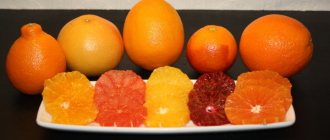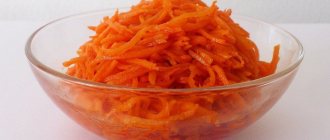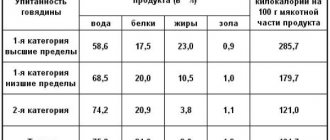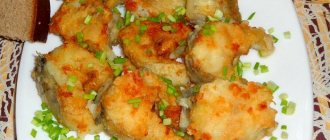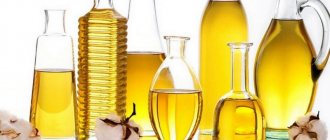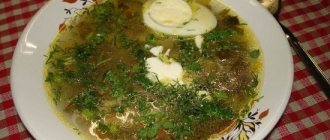Author: Kristina Lobanovskaya, doctor, practicing nutritionist Article updated: 05/18/2021
Mandarin is the fruit of the evergreen tree of the same name, which belongs to the Rutov family. It first became known in China, and today it grows in Spain, Turkey, Greece and other countries with warm climates. The fruits are characterized by a round or slightly flattened shape, as well as a sunny orange color. Inside, the citrus is divided into segments, the number of which can reach 12. The amazing aroma, special taste and low calorie content of tangerine make it a favorite product of the everyday and dietary diet.
Composition of mandarin
Tangerines (calorie content per 100 grams are quite low) have the following composition:
| Vitamin content | |
| Vitamin A | ˂60 mcg |
| Vitamin B1 | ˂60 mcg |
| Vitamin B2 | 30-35 mcg |
| Vitamin B3 | 0.35 mg |
| Vitamin B4 | 10 mg |
| Vitamin B5 | ˂200 mcg |
| Vitamin B6 | 80 mcg |
| Vitamin B8 | 190 mg |
| Vitamin B9 | 16 mcg |
| Vitamin C | ˂40 mg |
| Vitamin P | ˂30 mg |
Minerals:
| Potassium | 150-170 mg |
| Calcium | 35 mg |
| Phosphorus | 15-20 mg |
| Magnesium | 11-12 mg |
| Sodium | 1.5-2 mg |
| Iron | 0.1-0.15 mg |
Storage periods and features
After purchase, it is recommended to store tangerines in trays and the bottom shelf of the refrigerator. The approximate period is 10 days. But you shouldn’t wrap it in cellophane. There they quickly deteriorate and feel bad. You can place them on a special mesh, wrapping each fruit in paper and store for up to 1 month.
Many people believe that lemon is the best remedy for colds due to the largest amount of beneficial substances. However, this is a myth. Tangerines are no worse than their counterparts. If you eat 2 fruits a day, they will begin to fight pneumonia, thin and remove mucus, and reduce the temperature during colds. This is an excellent remedy for bronchitis and pleurisy.
It can be eaten exclusively by everyone in the absence of contraindications, especially women and children. Mandarin is an excellent preventative against excess fluid retention in the body for pregnant women. Relieves depression and chronic fatigue, has a beneficial effect on skin and hair. The product is low-calorie and helps during cold and flu epidemics no worse than classic lemon.
The benefits and harms of tangerine
Mandarin contains most of the vitamins and minerals the body needs to maintain immunity at a high level. Components such as potassium and sodium help relieve swelling. Glycosides prevent the development of atherosclerosis of blood vessels.
Essential oils promote the production of endorphins. Phenolic acid actively helps in the treatment of diseases of the respiratory system. Fruit extract is often used in cosmetics for dry and aging skin due to its nourishing and moisturizing effects.
Also, the main beneficial properties of tangerine include:
- prevention of respiratory diseases;
- decreased blood pressure;
- tonic effect;
- improved digestion;
- prevention of helminthiasis.
Mandarin is widely known as an ingredient in medicinal folk recipes. Fresh fruit juice helps with intestinal disorders and constipation.
To get rid of nausea, you should eat the peel of the fruit. Rubbing tangerine juice into the skin helps prevent fungal diseases. Syrups containing tangerine have proven themselves effectively in the treatment of bronchial diseases. The benefits of this fruit are not comparable to the harm that can only be caused by excessive consumption .
Medicinal properties of seeds and leaves
Tangerine seeds contain potassium and have antioxidant properties. They are used to prevent cancer and prevent aging of the body.
Vitamin A improves visual acuity and strengthens the optic nerves. Vitamins C and E in the seeds prevent the formation of free radicals and strengthen the immune system.
Mandarin leaves contain essential oil, phytoncides and flavonoids. Greens are used to treat colds - they have an antiseptic effect. The leaves can be used to relieve intestinal upset and diarrhea.
In cosmetology, tangerine leaves are used to relieve skin inflammation, to dilate and clog pores, and also to prevent premature aging of the skin.
Mandarin is completely useful. It can be eaten with seeds and peel, and this will not only not harm the body, but will also bring twice as much benefit.
Contraindications to the use of tangerines
Tangerines should not be consumed by people who have:
- individual intolerance to the fruit or its components;
- tendency to allergic reactions;
- gastritis;
- ulcer;
- nephritis;
- hepatitis;
- cholecystitis;
- diseases of the duodenum;
- high acidity of gastric juice.
Fruits from the citrus family are strong allergens and can therefore cause diathesis. It is not recommended to eat tangerines if you have inflammatory diseases of the digestive system.
What to cook from tangerines?
It is best, of course, to eat tangerines raw, whole with peel. But it is perfectly acceptable to use them in other ways.
For example, confectioners use tangerine slices to bake cakes and pastries. Housewives have learned to make jam from tangerines, and professional chefs prepare delicious sauces based on tangerines and often add them as a spice to cookies, fish dishes, salads, etc.
In addition, you can squeeze the most beautiful juice from tangerines. The main thing is that the tangerines are ripe and not spoiled, and the rest is a matter of technique...
Calorie content of dried tangerine per 100 g
Tangerines after drying have a calorie content per 100 grams reaching 500 kcal. When preparing dried tangerines, all the vitamins remain in them, and the moisture completely evaporates. In this form, fruits can be stored for a long time and are used in many dishes.
The figure shows the calorie content of tangerines per 100 grams.
It is advisable to wash industrially dried tangerines before eating, as they are treated with substances containing sulfur. If mold appears on the fruit, it is better to refuse to eat it.
Calorie content of peel and zest
When determining your calorie intake, it is important to calculate the nutritional value of each meal, including snacks. Often people ignore the need to count the calorie content of all foods that enter the body. Because of this, it becomes difficult to calculate the exact caloric content of the diet.
When using peels and zests, it is necessary to take into account that, regardless of the variety, they contain 34-38 kcal.
There is no need to stop eating the crust. Some people add it to baked goods, others make candied fruits or use it in making infusions. The peel and zest contain beta-carotene, vitamins A and P, which are necessary to improve heart function and prevent disorders in the functioning of the vascular system. Also includes:
- glycosides;
- phytoncides;
- pectin;
- cellulose;
- organic acids.
We recommend that you familiarize yourself with Tangerines and diabetes
Regular consumption of tangerines with the skin prevents the formation of cholesterol plaques. This method of eating fruits helps normalize digestion and relieve cough.
How does tangerine help you lose weight?
The issue of losing weight has always been relevant for women, and tangerines are good helpers in this matter. The fat content in this fruit is very low, so it can be safely included in the diet. The advantage is the diuretic effect of tangerine and the fact that it is quickly digested by the body.
With a low calorie content, the fruit contains a lot of useful substances that help keep the body in good shape and not gain weight. The fruit is great for daytime snacking and replaces high-calorie desserts, but you should limit yourself to 3-4 tangerines per day.
Scientists have proven that flavonoids in citrus fruits help fight excess weight. Tangerines also speed up metabolic processes in the body, which is important for weight loss. The big advantage is that tangerines can be eaten almost all year round. Nevertheless, the organic acids in the fruit can provoke an increase in appetite, so it should be consumed in moderation.
Beneficial features
Mandarin is rich in vitamin C, which is contained in one piece at a level of 42.2%, thanks to which consumption of the product strengthens the immune system. Ascorbic acid takes part in redox reactions and increases the absorption of iron. Other beneficial properties of the fruit:
- Tangerines have a beneficial effect on the digestive tract, speed up metabolism and eliminate dysentery.
- The fruits have an antibacterial effect, so their juice is used to treat skin diseases.
- The fruit is used for severe bleeding as a hemostatic agent.
- Dried tangerine peel is brewed as tea. This drink has a sedative effect.
- Tangerine decoction for inhalation procedures helps improve health in case of respiratory diseases and problems with the respiratory system.
Consumption of tangerines:
- reduces thirst at elevated body temperature due to influenza;
- reduces the risk of heart and vascular diseases;
- reduces blood cholesterol;
- regulates insulin in patients.
If you have any medical conditions, you should consult your doctor before consuming tangerine.
For weight loss
Regular consumption of tangerines helps prevent fatty liver. Fruits help reduce fat accumulation in the abdominal cavity. It has been proven that if you drink tangerine juice and do physical exercise, you can easily lose excess weight.
There is a special diet that helps you get rid of excess body weight. For 4 days you need to eat 1 kg of fruit, drink tea without sweet additives, juice and exercise. This way you will be able to get rid of 5 kg.
You can eat tangerine to prevent the accumulation of extra pounds thanks to the flavonoids in its composition.
Is it possible to eat tangerines in the evening while losing weight?
It is advisable to eat tangerines in the morning or before lunch due to their high content of simple sugars and carbohydrates. This product is not one of the lowest calorie and dietary products, but 1-2 fruits a day will only benefit the body. If you eat tangerines at night, carbohydrates can be deposited in unwanted extra pounds.
But if dinner consists of tangerine in combination with protein foods, this will prolong the feeling of fullness and slow down the process of carbohydrate absorption. This diet will not cause heaviness in the stomach or discomfort. If you are on a strict diet, it is better to eat tangerines no later than 5 pm.
How to choose and store correctly
Ripe and healthy fruits should be bright orange in color and free from blemishes, mold and rot. To determine the level of ripeness of a citrus, just place it in the palm of your hand: the right fruit will feel a little heavier for its size. The heavier the fruit, the more juice it contains. On the contrary, you should not take very light and soft fruits. Another evidence of the quality of the fruit is its aroma. It should be fresh, intense and free of chemical impurities [14].
It is better to store tangerines in a cool place, avoiding direct sunlight. The fruit will last up to 2 weeks in the refrigerator. And one more important note: tangerines do not tolerate high humidity, so it is strictly not recommended to store these fruits in closed plastic bags. You can extend the “life” of fruits by lubricating their skins with vegetable oil or wax, which act as natural preservatives.
Tangerine diet: basic principles, menu for 3 days
Mandarin (calorie content per 100 grams is about 35 kcal) includes a large amount of fiber. Thanks to this, digestion processes are accelerated and a feeling of fullness comes. Pectin in the composition gives the body energy, and flavones promote weight loss. The substances contained in tangerine break down fats and speed up metabolism.
Thanks to research, scientists have found that this fruit provokes the burning of fat in the abdominal area and prevents fatty liver.
Tangerine juice is not the most optimal dietary product, but it can still be included in the menu if:
- drink juice in the morning;
- do not combine with high-calorie ingredients;
- consume with fermented milk products.
You should eat no more than 200 g of tangerines per day so as not to disrupt your proper nutrition regimen.
The fruit goes best with the following products:
- porridge (rice, oatmeal);
- low fat meat;
- seafood;
- fruits, berries, other citrus fruits;
- dairy products.
You should not combine tangerines with legumes and dishes containing starch. Regular fasting days with tangerines are one of the effective methods of losing weight. Once a week, you can limit the menu to this fruit, if there are no diseases of the digestive system.
You can eat no more than 1 kg of tangerines per day, while drinking enough water. Fasting days can be repeated 3-4 times a month, on subsequent days limiting your consumption of flour dishes and desserts.
One of the popular ones is the egg-tangerine diet. In 4-5 days you can lose 2-4 kg. Daily diet: 4-5 eggs and 3-4 tangerines. The servings alternate between eggs, tangerines and egg whites. You need to eat every 2 hours, and drink more fluids during breaks.
Sample diet menu with tangerines for 3 days:
| 1 day | breakfast | oatmeal with tangerine slices |
| dinner | boiled chicken, lettuce leaves | |
| dinner | tangerine, glass of kefir | |
| Day 2 | breakfast | rice porridge, tangerine |
| dinner | baked duck with vegetables | |
| dinner | fruit salad | |
| Day 3 | breakfast | salad with seafood and tangerine |
| dinner | boiled eggs, vegetable salad | |
| dinner | cottage cheese, tangerine |
Mandarin can be used as a spice for rice, meat and fish dishes, and in sauces. The fruit can be a component of various salads and baked dishes.
Dried
Dried tangerine fruit can be consumed as a healthy and completely unusual snack, or can be used during cooking or as a decoration for baked goods. The delicacy is made from fresh citrus fruits using heat treatment. Like any other product, citrus fruits lose a lot of moisture during drying, which affects their energy value. What is the calorie content of dried tangerines? Definitely high - sometimes it can reach 320 kcal for every 100 g.
Important! Dried and dried tangerines are different products. The difference is obvious even in the matter of calorie content: if dried slices are considered very high in calories, dried ones, that is, retaining more moisture, are quite suitable for losing weight, since their calorie content does not exceed 52 kcal per 100 g. Of course, this is subject to the refusal to use sugar syrup at the moment manufacturing.
Dried fruits, like fresh ones, are a source of large amounts of vitamins and minerals. Organic fibers are also preserved, so at the time of consumption, intestinal motility is stimulated and the functioning of the gastrointestinal tract is improved. It is noteworthy that dried and sun-dried fruits have an equally good effect on metabolism and help improve immunity.
Dried fruits have a slight diuretic effect, which helps to overcome swelling.
To always have a healthy snack on hand, you don’t have to buy a ready-made product. You can dry citrus fruits yourself using the oven. To begin with, take several ripe fruits, wash and dry them. Cut into thin slices (no need to remove the peel). Place the slices on a baking sheet and place in an oven preheated to a maximum of 70 degrees. The process takes about 40 minutes. Afterwards, turn the slices over (repeat 2 more times). Once the slices have cooled, place them in an airtight container. Drying tangerines using a special fruit dryer is even easier. The optimal time is 4-5 hours.
Dietary recipes with tangerines
There are many culinary recipes that include tangerines and allow you to maintain your figure.
Hawaiian pudding
Ingredients:
- milk – 1 l;
- rice – 1 glass;
- tangerines – 2 pcs.;
- orange – 1 pc.;
- apple - 1 pc.;
- banana – 1 pc.;
- cherry – 200 g;
- water – 600 ml;
- sugar – 150 g;
- raspberry jam – 1 tbsp;
- vanillin – 1 g.
Bring milk to a boil, add rice and sugar. Cook for 15 minutes over low heat, add vanilla. Stir and leave until the liquid is completely absorbed. Peel the fruits, divide them into slices, cut apples and bananas. Boil fruit syrup and add jam. Place the resulting pudding on a plate, put fruit on top, and pour syrup over it. Serve immediately after serving.
Fruit salad
Compound:
- tangerines – 3 pcs.;
- bananas – 2 pcs.;
- kiwi – 2 pcs.;
- apples – 2 pcs.;
- low-fat yogurt – 100 g.
Peel the fruits, cut into cubes, mix. Season the salad with yogurt. You can sprinkle orange zest on top, decorate with prunes, dried apricots, and nuts. You can add berries depending on the season.
Canned tangerine and apple compote
Ingredients:
- tangerines – 4 large;
- apples – 2 pcs.;
- sugar – 150 g;
- water – 1 l.
Wash and peel the tangerines thoroughly. Cut the peel into thin strips. Divide the tangerine into slices. Peel the apples and cut into cubes. Place zest, apples and tangerine slices into boiling water. Cook for 10 minutes, add sugar, cool. Next, pour the compote into jars and tighten.
Light salad with tangerines
Components:
- chicken fillet – 350 g;
- shrimp – 200 g;
- tangerines – 5 pcs.;
- yogurt – 500 ml;
- celery – 6 pcs.;
- greenery;
- salt.
Boil chicken fillet in salted broth. Cut the meat into small pieces. Wash the celery, peel and cut into cubes. Peel the tangerines and divide into slices. Cook shrimp for 3 minutes. Place the ingredients in a glass, add salt and pour over yogurt. Garnish the salad with fresh herbs.
All of the recipes listed are low in calories and fit well into the diet menu.
Dishes
Tangerines are wonderful fresh, which is why they are most often consumed this way. Thanks, again, to their low calorie content, these fruits can be easily included in the diet menu, or even used in a special diet for weight loss (there is a diet based on tangerines, which allows you to become 2-3 kg lighter in just a few days). A pleasant feature of citrus is its resistance to nitrates, which makes it completely beneficial for the whole body.
Unfortunately, you won’t be able to eat large quantities of fresh tangerines – it can lead to yellowing of the skin. It is much better to diversify the menu with fresh dishes with the addition of orange fruit.
Juice
Like fresh fruit, tangerine juice is endowed with high gastronomic qualities and a lot of beneficial properties. In culinary terms, the drink is popular and can easily replace even orange, which is characterized by high acidity. Fruit salads, sorbets and desserts containing tangerine juice are especially popular among chefs and ordinary housewives.
It is noteworthy that even with long-term storage, juice is able to retain almost the entire range of benefits. It contains more ascorbic acid than other citrus fruit juices. The drink has the most beneficial effect on the gastrointestinal tract. And not so long ago, scientists found that it is able to fight obesity. Among other things, the juice is a good natural antidepressant. Active substances that have a positive effect on the nervous system are represented by essential oils.
The calorie content of the aromatic juice is low - only 36 kcal per 100 g. It becomes obvious that this is an excellent diet drink.
To make juice at home, you can use a juicer or a regular blender. 1 kg of fruit is peeled and divided into slices. If a blender is used, the pulp is crushed and then filtered using a sieve. If desired, you can add sugar to the finished juice, but this will only increase the calorie content, which is undesirable when losing weight.
Compote
Compote is made from the zest. The result is a refreshing vitamin drink, the calorie content of 100 grams of which is 40 kcal.
To prepare 500 ml of compote, take the zest of 2 tangerines. After boiling, boil for a quarter of an hour, and then let it brew for at least 1.5 hours. Next, the zest is removed. Add 1 tablespoon of honey and sugar to the compote. Bring to a boil. Juice is squeezed out of the fruit pulp and added to the compote.
Smoothie
A nutritious smoothie with a calorie content of 78 kcal per 100 grams - an ideal option for those who are watching their figure or are on a diet. It can easily replace breakfast and make a good snack.
One banana is cut into pieces and put in the freezer for half an hour. Two tangerines are freed from peel, veins and seeds. Pour 150 ml of soy milk into a blender bowl, add banana and tangerines. Also add a pinch of sesame seeds. Add the same amount of chia seeds and beat for about 3 minutes. Insist for 10 minutes.
Jema
Slightly sour citrus slices look especially suitable for making unusual jam. Squeeze the juice out of 1.5 kg of peeled fruit (about 600 ml). The juice is poured into a convenient container, where 200 ml of water is added. Bring the liquid to a boil and boil until its quantity is reduced by a quarter. Next, add 400 g of sugar and pectin (follow the instructions on the package). Continue cooking for at least 20 minutes. During this time, the jam will become darker and denser. The finished product is poured into glass jars and sent to the refrigerator. The calorie content of tangerine jam is not too high - about 120 kcal for every 100 g, but on a diet you can not eat it too often, and certainly not in the evening.
Salatov
Fragrant citrus slices add a touch of freshness to salads. Due to its low calorie content, the fruit can be included in dishes without fear of gaining weight. Two salads are recognized as the best from the point of view of consumption during weight loss:
Beetroot
The salad requires few ingredients, and it is prepared quickly and easily.
Boil beets (5 pcs.) until tender. Let it cool. Dip beet tops into salted boiling water. Boil for 3 minutes. Then drain in a colander and pour over ice water. In a separate container, mix the juice of 1 tangerine, 1 teaspoon of natural liquid honey, 2 tablespoons of 9% vinegar, 2 tablespoons of olive oil, a pinch of ground black pepper, salt and fresh herbs. The cooled beets are grated on a coarse grater, and the tops are also chopped. Two tangerines are peeled and freed from films, then cut. Mix all the ingredients and pour over the sauce. The calorie content of 100 g of salad is 81 kcal. At the same time, you can use it even in the evening, since beets cleanse the body well.
With radish
A spicy salad is made from white radish (it should not be too small). It is cleaned and grated on a medium-sized grater. One apple is peeled and cut into strips. Radish and apple are combined in a salad bowl and lightly salted so that they give juice. Half a bunch of fresh herbs is chopped, 1 pc. onions cut into half rings. 2 tangerines are peeled, each slice is divided into 2 parts. All ingredients are mixed and poured with olive oil. The calorie content of the finished salad is 90 kcal per 100 grams.
soup
A spicy soup with a low calorie content - 89 kcal per 100 grams - will appeal to gourmets. To prepare it, take 50 g of rice. Boil until done. Grate the zest of 1 tangerine. Add the zest to a saucepan with 250 ml of water. 4 teaspoons of granulated sugar are also added there. Bring to a boil. 2 teaspoons of starch are diluted with cold water and placed in a saucepan. Bring to a boil again and cool. The slices of two tangerines are cut into slices. Pour in cooled syrup, add rice and a little sour cream.
What a quality tangerine should be like: tips for choosing citrus
Different varieties of tangerines differ in:
- taste;
- color;
- aroma;
- acidity.
One of the sweetest fruits is the Pixie variety. It has juicy pulp with virtually no seeds and a peel with pronounced pores. Satsuma tangerines are sweet and sour and have thick skin. Their lobes are of different sizes.
Hybrids of tangerine with grapefruit and orange have greater sweetness and brighter color. Tangerine peels may be treated with harmful chemicals, so it's worth paying attention to their color and texture.
You should not buy fruits if the following are noticeable on the skin:
- white coating;
- stickiness;
- waxy shine;
- damage and bruises;
- brown spots.
Tangerines must be washed before consumption and it is better not to eat the peel, as the fruit is often processed for long-term storage. If the fruit is frozen, the peel looks wrinkled and thin. Fruit infected with parasites has dark spots of rot.
The taste of fruits depends on where they are grown:
- Tangerines from Abkhazia have pronounced acidity, small size, and yellow-orange skin. The fruits are easy to peel and contain few seeds.
- Fruits from Turkey are honey-sweet and contain many seeds. The peel is bright orange and difficult to separate.
- Spanish tangerines are deep orange, sweet and sour, and contain few seeds. The fruits are large, with thick skin.
- Tangerines from Morocco are flattened, with a yellow tint, and seedless. The fruits are sweet and juicy.
- Israeli tangerines are dry, thin-skinned and have a sweet taste.
When buying tangerines, you should pay close attention to their appearance. The fruits must be clean, without spots or streaks. The color of the fruit is uniform. The peel should not be shiny or sticky. The richer the color of the tangerine, the sweeter its taste. If you lightly press the skin, the juice should come out.
Large tangerines have a sour taste. The fruit should have a fresh citrus aroma. The fruit should be elastic and without damage. Mandarin (calorie content of fruit per 100 grams is 35 kcal) is a healthy and valuable fruit that must be included in a healthy diet.
Fresh
The beauty of tangerine, in addition to its taste, lies in the ease of separating the skin from the pulp, which makes it superior to orange and grapefruit. Some varieties lack seeds. But a large amount of vitamin C, like other citrus fruits, is present. At the same time, ascorbic acid remains in fruits for such a long time that even last year’s harvest is beneficial and nutritious. In general, tangerine is a fruit quite rich in vitamins and minerals. Thanks to the ideal ratio of sodium and potassium, citrus acts as a good decongestant, and the antiseptic and phytoncidal properties allow the fruit to prevent respiratory diseases.
Experts point out that orange slices are useful for a number of pathological conditions of the gastrointestinal tract, and also treat helminths. It has been established that their regular use restores strength and reduces blood pressure. Considering the high content of essential oils, which have a positive effect on the psycho-emotional state, it becomes obvious that the fruit can be called the best way to improve mood.
Important! If you eat at least one tangerine every day, almost all organs and systems of the body will return to normal, including the cardiovascular system.
Another invaluable quality of citrus fruits is the acceleration of the weight loss process. Firstly, they help normalize metabolism and reduce blood sugar levels. Secondly, they are fruits with low energy value - on average it is at the level of 38 kcal per 100 g, and the calorie content of 1 piece, the weight of which often reaches 50-60 g, is about 20 kcal.
The calorie content of tangerine without peel is also average, reaching 27 kcal per 100 grams. Why are indicators taken on average? This is primarily due to the existence of different varieties of citrus products, differing in taste, color, size, and the presence or absence of seeds. Spanish and Israeli fruits are always sweet, as well as the Temple, Robinson, Mineola and Honey varieties.
All tangerines, regardless of variety, size and other factors, are very beneficial both for the figure and for the body as a whole.
Moroccan citrus fruits deserve special attention from Russian consumers. They are very sweet, although they have a pit. The calorie content of tangerines from Morocco is 39.5 kcal per 100 g.
In addition to the “traditional” orange fruits, you can find more sophisticated ones on store shelves:
- Clementine
A fruit called Clementine (also known as red tangerine) is also very popular. In fact, it is a hybrid of a king orange and a mandarin. Externally, it is not much different from ordinary citrus, except that it has a more intense peel color and a large number of seeds. It is noteworthy that Clementine reaches a medium size, and even looks small in comparison with traditional tangerines. Due to their pronounced sweetness, the calorie content of small tangerines is higher - about 47 kcal per 100 g, but the figure does not go beyond what is allowed when losing weight.
- Satsuma
The plant is a variety of tangerine. The fruits, flattened on both sides, are covered with a thin orange-colored peel, under which there is juicy pulp. It contains virtually no seeds. The energy value of 100 g of Satsuma is no more than 53 kcal. Average weight 1 pc. – 70 grams.
Important! The glycemic index of fruit can reach up to 50 units (usually from 46 to 49), which also depends on the variety. This is higher than the GI of apples and zucchini, but lower than the GI of watermelon, dates and dried apricots. It is worth considering that the glycemic index of the whole fruit is lower than that of freshly squeezed juice!
Tangerines are a healthy and positive snack, but their culinary qualities are not limited to this. Aromatic juice is squeezed out of the fruits, preserves and jams are prepared, they are added to baked goods and desserts, and sometimes even to meat. The peel is used to make zest, candied fruits and dry rinds - this is an excellent seasoning for poultry dishes.
When choosing bright citrus, you need to pay attention to the integrity of the skin, which should be free from dents, abrasions and dark spots. You should avoid buying dry and dull fruits, as their pulp may be spoiled. Store the product in a cool place. Optimally - in a special compartment of the refrigerator for fruits and vegetables.
Daily intake of tangerines
Despite all the benefits of orange fruit, you should not overeat them at all. Since excessive consumption of tangerines can cause an oversaturation of the human body with vitamin complexes and cause the development of hypervitaminosis, the clinical signs of which manifest themselves in the form of a rash, headaches and high blood pressure. It is recommended for an adult to eat no more than 200 grams of tangerines per day, for children a little less, within 150 grams. The same restrictions apply to the consumption of tangerine juice. Children are allowed to consume no more than 150 ml of juice, adults can consume 200 ml per day. Compliance with the norm of consumption of orange fruits will help you receive only benefits from them and true enjoyment of their sweet and sour taste.
Chemical composition and nutritional value
In terms of the content of proteins, fats, carbohydrates, and other substances involved in digestion, tangerine differs little from other citrus fruits: it has a lot of water, fiber, enough carbohydrates and very little fat.
Nutritional value of tangerines:
- Water – 88%
- Fiber – 1.9%
- Proteins – 0.8%
- Fats – 0.2%
- Carbohydrates – 7.5%
Carbohydrates in tangerines are mainly represented by sugars, which gives it a special festive taste and makes it a favorite treat for children and adults at the New Year's table. In terms of the content of vitamins and nutrients, tangerine is in no way inferior to its older brother orange. Like all citrus fruits, tangerines are rich in ascorbic acid, which strengthens the immune system, protects the oral cavity from inflammation, and skin cells from aging; together with flavonoids, it promotes the rapid removal of toxins and waste from the body.
Important: the high content of vitamin C in tangerines prevents the accumulation of nitrates in them, so you can eat them without the risk of poisoning.
“Golden fruits” are also rich in beta-carotene, which acts in the body like vitamin A - improves vision, maintains skin firmness and elasticity. They also contain vitamin PP - nicotinic acid, which, among other things, stimulates the production of the “joy hormone” serotonin, helping to maintain a festive mood and optimism. Potassium and magnesium - for the heart, silicon and calcium - to strengthen bones, iron - to improve blood composition. Each tangerine is like a wonderful micro-pharmacy: it supports, heals, and helps to endure winter storms.
